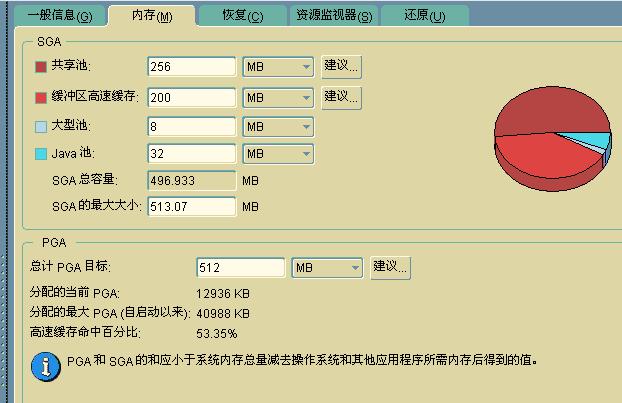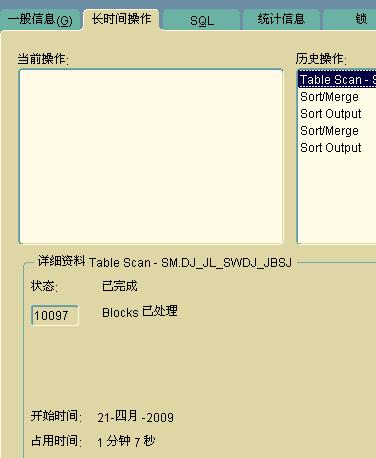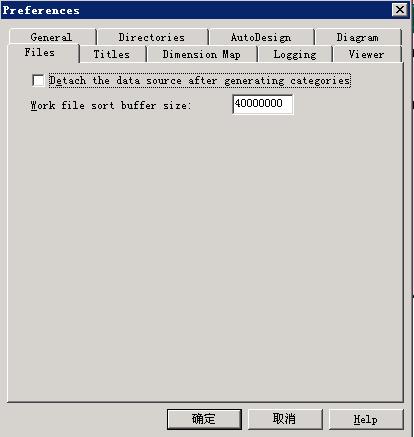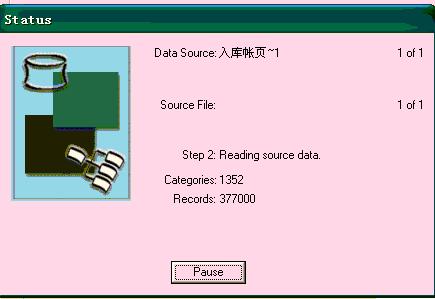Cognos8.3 + oracle9i数据集市 建cube性能调整
本次要给客户作一个演示,所以环境都是临时搭建的。
具体环境如下:
DB: Oracle9i, 内存:512M,xpsp2
cognos:cognos8.3,内存:2G,xpsp2,硬盘:WD3200AAJS-08L7A0
数据:
主表28w,明细:200w(3个月),字典表4个,分别为 700,122,131,4
日期粒度到天
第一步:
现象:在transformer中执行建cube后就没有反应了,DB Server CPU等都没有什么反应。
实验了很多,把抽取数据的SQL那出来,单独在SQLPLUS中执行也如此。
哪怕是只去前100行数据,也是没有反应。实验了很多,也没有反应。
原因:查看数据表,发现索引不全,字典表是临时建的,没有索引。
给所有表加索引,给所有外键关联的键值加索引。
在次执行前100行数据,2,3秒内就能出来。
结论:索引是必要的。忘记了,你就等吧
第二步:
现象:在transformer中执行建cube后就没有反应了,DB Server CPU等都没有什么反应。和第一步中没有多大区别
原因:打开OEM,查看session,发现session长时间操作,很慢,读取block一个个读取,剩余时间居然是n天
查看内存参数配置,oracle默认的配置很低。经过多次尝试,参数调整结果如下图:
db Buffer:200
sort_area_size:10M , 默认居然是512K
pga:512M,默认大概48M
一开始调整后连入的session的uga都不大,后来在网上查到一位大侠测试结果,说一个uga大约相当于pga的 6% ,所以吧pga调整到512M
这样,session的uga大约能达到40M左右
share pool size:256M
临时表空间一定要有足够的地方,这个例子发现临时表空间大约用到了3G的样子
调整是逐步的,每次调整后,都发现28w的表的扫描能快上不少,最后调整的结果是执行这个结果大约在5分钟可以完成。
结论:olap的参数和trans的参数还是要有一定区别的,尤其是在建cube的时候,是少并发,大数据量读取,所以各种参数一定要跟上。
第三步:
现象: transformer 读取数据后,报错如下:
RQP-DEF-0177 An error occurred while performing operation 'sqlOpenResult' status='-28'.
UDA-SQL-0114 The cursor supplied to the operation "sqlOpenResult" is inactive.
UDA-SOR-0005 Unable to write the file.
google&baidu后,在ibm的网上说是cognos安装目录下的磁盘空间不够。查看硬盘,还有70G啊。然后就监控cgnos_home/cognos8/temp/目录,实验几次后,发现每当临时文件增长到大约4G就报错,然后文件就没了。几次三番后想是不是xp的问题,查看分区后,居然发现分区格式是FAT32的,晕死!!这么大的硬盘居然是FAT32,然后就是转分区格式,幸好XP提供了 convert 这个命令,执行后要求重新启动,再次transformer后,临时文件直达10g左右后才完成
CONVERT volume /FS:NTFS [/CvtArea:filename]
原因:FAT32最大支持4G的文件,其实可能都不足4G,而且性能低下,不管是什么用途的机器,赶紧转换吧
结论:XP下绝对要用NTFS分区,
第四步:
现象:transformer从db中读取数据后,依然很慢,3个小时后才弄了两三千行行数据。
又是google&baidu 一通乱搜,后来发现其实TCognos 8 Transformer User Guide 中就有说明,
原因:cognos默认排序为5,000,000,最大65,000,000
在tranformer中,File->preferences->File (Tab) 中
结论:我修改到60,000,000 效果是能看到cube记录在增长,监控硬盘读写,读写速度均在15M左右浮动,读写比率在80%之上,查看该款硬盘的性能评测,单纯读或写,在近100M。应该也已经是接近饱和吧
通过以上4步,例子应该可以完成了,目前已经32w了,还不知道最终什么时候能完成。
transformer的参数调整在手册的Reducing Build Times for Large PowerCubes 这一节,简摘如下:
unix可以设置的参数多写,windows相对少些
Recommendation - Optimize the Operating Environment
You can adjust various settings, whether operating in UNIX/Linux or Windows environments, to shorten your cube build times.
We recommend that you optimize your system by changing various default settings, as follows:
WriteCacheSize (仅unix可调)
On UNIX or Linux servers, the default value for this setting is 32768 (32 MB). Doubling the value to 65536 (64 MB) or tripling it to 98304 (96 MB) is recommended to optimize larger UNIX or Linux systems.
To modify the WriteCacheSize setting, open the ppds_cfg.xml.sample file located in the installation_location/configuration directory. After you change the WriteCacheSize setting, save the file in the same directory as ppds_cfg.xml.
Sort buffer size (windows可调)
The sort buffer size used for local processing is specified as a preference setting on Windows and UNIX/Linux:
On Windows, set the Work file sort buffer size on the File tab of the Preferences dialog box.
On UNIX/Linux, set the sort buffer size using the WorkFileSortSize command.
The default setting is 8000000; however, you can raise the amount of physical memory available for sorting data during the consolidation and auto-partitioning process.
TEMPFILEDIRS (Windows only)
You can change the location of the temporary files that are created whenever sorting is done. We recommend that you specify multiple directories, separating each with a semicolon.
MaxTransactionNum (Windows only)
This setting limits the number of records that can be processed in temporary files before a checkpoint is inserted and records are committed to the PowerCube. To reduce cube build time, try raising the setting from its default (500000) to 800000. Or, if you get error message TR0112 during a cube build, lower the setting so records are committed more frequently, thereby freeing up space.
You change this setting on the General tab of the Preferences property sheet.
Ulimit (UNIX/Linux only)
Typically, you specify a value for this setting, such as 67 MB for a 2 GB-capacity server, so that system resources get shared effectively among competing processes. However, when operating Transformer on HP-UX, we recommend that you set this environment variable to unlimited, to provide the cube build process with as much physical memory as possible. (For other UNIX platforms or Linux, consult your operating system documentation to learn how you can best tune your kernel settings to allocate sufficient memory for Transformer.)
Tip: Type the command ulimit -a to determine the currently assigned values for Transformer. The time, file, and memory settings should show a value of unlimited.
----------------------------------------------------------------------
Recommendation - Optimize Gateway Settings for Series 7 IQDs 数据库连接优化
To further shorten the data read phase for Series 7 IQDs, you can change the database-specific settings found in the gateway .ini files included in the Transformer installation directory.
Search for a file name such as cogdm*.ini, where the asterisk represents a specific database version. The entries in each gateway .ini file are different, depending on the database type.
Note: For Cognos 8 data sources, see the Cognos 8 Architecture and Deployment Guide.
Example - Change Oracle Database Settings
Oracle uses the cogdmor.ini gateway file for database-specific settings. We recommend you consider adjusting the following settings:
Fetch Number of Rows
Increasing the number of rows to fetch in each fetch operation can improve performance on some systems. Although the current limit for this number is 32767, numbers larger than the default (100) may degrade performance on some systems.
Fetch Buffer Size
Increasing the size of buffer used during fetch operations from the default (2048 bytes) can improve performance on some systems.
Where both entries have
Cognos8.3 + oracle9i数据集市 建cube性能调整相关推荐
- Oracle 优化和性能调整
Oracle 优化和性能调整 分析评价Oracle数据库性能主要有数据库吞吐量.数据库用户响应时间两项指标.数据库用户响应时间又可以分为系统服务时间和用户等待时间两项,即: 数据库用户响应时间=系统 ...
- 九、OLTP 性能调整与优化--结语
OLTP性能调整与优化--结语 根据软件生命周期的瀑布模型,应用程序的性能在其设计阶段就已经有了质的定性.如果在应用程序开发完成之后才想到优化,一般就只能治标不治本,在遇到严重的性能问题时,甚至需要将 ...
- DB2数据库性能调整和优化(第2版)
<DB2数据库性能调整和优化(第2版)> 基本信息 作者: 牛新庄 出版社:清华大学出版社 ISBN:9787302325260 上架时间:2013-7-3 出版日期:2013 年7月 开 ...
- WebSphere Application Server性能调整工具包
IBM已发布了WebSphere Application Server性能调整工具包 ,该工具包具有从Eclipse工作区*监视多个 WebSphere Application Server的功能. ...
- sql server 性能_SQL Server硬件性能调整
sql server 性能 SQL Server Performance Tuning can be a difficult assignment, especially when working w ...
- semaphore性能问题_SQL Server性能调整– RESOURCE_SEMAPHORE等待
semaphore性能问题 When dealing with SQL Server performance tuning waits, we may see RESOURCE_SEMAPHORE w ...
- 查询sql执行计划_使用SQL执行计划进行查询性能调整
查询sql执行计划 In the previous articles of this series (see the index at bottom), we went through many as ...
- nginx静态资源 性能_如何欺骗生产环境资源以进行性能调整
nginx静态资源 性能 Performance tuning is one of the most important and critical tasks that the SQL Server ...
- Apache Sqoop性能调整
Sqoop 是 Apache 基础提供的一种工具,在大数据世界中通常用于异构关系数据库 (RDBMS) 和 Hadoop 分布式文件系统 (HDFS) 之间的导入-导出数百万条记录.这种数据传输可能导 ...
最新文章
- (转载)机器学习知识点(十一)隐马尔可夫模型
- ADO.NET Entity Framework 入门示例向导(附Demo程序下载)
- 如何将usb摄像头连接到虚拟机vmware ubuntu系统上?
- Google今日更新PR值,帆船书会由1升到了3
- HFileOutputFormat与TotalOrderPartitioner
- P1090-合并果子【离散化,队列,时间复杂度O(n)】
- 企业实战_03_Redis基础命令
- 数据结构思维 第四章 `LinkedList`
- Effective Objective-C 2.0 — 第二条:类的头文件中尽量少引入其他头文件
- 关于Android的学习
- 计算单应性矩阵 python_计算视觉——相机参数标定法
- 领域驱动设计核心概念
- 笔记本win7共享WIFI
- 判断质数和合数python代码_【奇技淫巧】利用正则进行需要整除操作的判断,如:奇偶性,质数合数...
- 1.新建laravel项目
- css选择器有哪些?
- 有哪些可以快速回复信息的软件
- Windows、Mac系统常用的SSH工具软件整理汇总
- Eversipn STT-MRAM的MJT细胞
- Android多媒体开发(2)————使用Android NKD编译原版FFmpeg




